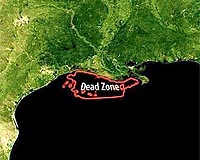| . |  |
. |
Washington (AFP) March 15, 2010 Adding iron to the world's oceans to capture carbon and fight global warming could do more harm than good, as the mineral appears to boost the growth of a plankton that produces a deadly neurotoxin, a study published Monday shows. Researchers led by Charles Trick of the University of Western Ontario in Canada found that fertilizing the ocean with iron can boost the growth of Pseudo-nitzschia, a phytoplankton that produces a component of the neurotoxin, domoic acid. Humans who eat shellfish or crab that have ingested Pseudo-nitzschia could get amnesic shellfish poisoning (ASP), severe cases of which can cause neurological symptoms, including permanent, short-term memory loss, which gives the intoxication its name. Amnesic shellfish poisoning can also be fatal. For the study, which was published in the Proceedings of the National Academy of Sciences, the researchers examined water samples taken from open-ocean tracts in the sub-Arctic North Pacific Ocean where iron-fertilization experiments were conducted. They found that the population of Pseudo-nitzschia had doubled compared to controls, that adding iron to the water appeared to increase the amount of domoic acid produced by individual phytoplankton, and that the natural release of the toxin boosted further growth of the potentially harmful plankton. Previous iron-enrichment experiments have focused on studying how adding iron to the sea affects carbon cycling, but have overlooked the potential ecological impacts of geo-engineering-designed fertilizations, the study, which was published in the Proceedings of the National Academy of Sciences, says. Earlier studies by other teams have shown that iron fertilization produced no measurable quantities of domoic acid, and that some coastal Pseudo-nitzschia produced only low concentrations of the toxin. Iron fertilization is still mainly in the experimental phases, with about "12 experiment-sized iron fertilizations" already undertaken, mainly in the Pacific Ocean, Trick told AFP. The findings of the study he led raise "serious concern over the net benefit and sustainability of large-scale iron fertilizations." Scientists in the 1990s began fortifying small areas of the ocean where the sea water is rich in nutrients but low in plankton, to see if adding iron to the water would stimulate the growth of phytoplankton and boost carbon capture. Adding iron resulted in rapid growth of the phytoplankton, which, in the process of photosynthesis, uses energy from sunlight to fix inorganic carbon in surrounding surface waters to produce organic carbon. Some of the organic carbon ends up deep in the ocean, effectively removing carbon from the surface waters, while surface-water carbon is replenished by taking carbon dioxide from the atmosphere. Iron fertilization, like other forms is geo-engineering is "purposely changing the system and may have unintended consequences," said Scott Doney, a senior scientist at Woods Hole Oceanographic Institution in Massachusetts, commenting to AFP on the findings. "You have to weigh how the changes affect higher animals, how it affects fish and mammals," said Doney, who did not take part in the study. "You have to know what are the trade-offs between how much carbon you actually store and how big an effect you have on the environment," he said.
Share This Article With Planet Earth
Related Links Water News - Science, Technology and Politics
 Aquatic Dead Zones Contributing To Climate Change
Aquatic Dead Zones Contributing To Climate ChangeCambridge MD (SPX) Mar 15, 2010 The increased frequency and intensity of oxygen-deprived "dead zones" along the world's coasts can negatively impact environmental conditions in far more than just local waters. In the March 12 edition of the journal Science, University of Maryland Center for Environmental Science oceanographer Dr. Lou Codispoti explains that the increased amount of nitrous oxide (N2O) produced in low-oxyg ... read more |
|
| The content herein, unless otherwise known to be public domain, are Copyright 1995-2010 - SpaceDaily. AFP and UPI Wire Stories are copyright Agence France-Presse and United Press International. ESA Portal Reports are copyright European Space Agency. All NASA sourced material is public domain. Additional copyrights may apply in whole or part to other bona fide parties. Advertising does not imply endorsement,agreement or approval of any opinions, statements or information provided by SpaceDaily on any Web page published or hosted by SpaceDaily. Privacy Statement |